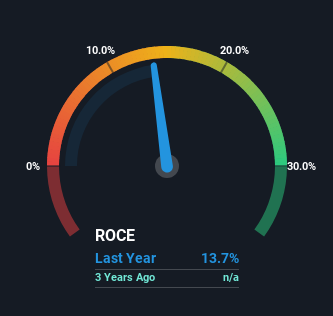Returns At Hiap Seng Industries (SGX:1L2) Appear To Be Weighed Down
What trends should we look for it we want to identify stocks that can multiply in value over the long term? Ideally, a business will show two trends; firstly a growing return on capital employed (ROCE) and secondly, an increasing amount of capital employed. If you see this, it typically means it's a company with a great business model and plenty of profitable reinvestment opportunities. However, after briefly looking over the numbers, we don't think Hiap Seng Industries (SGX:1L2) has the makings of a multi-bagger going forward, but let's have a look at why that may be.
Understanding Return On Capital Employed (ROCE)
For those who don't know, ROCE is a measure of a company's yearly pre-tax profit (its return), relative to the capital employed in the business. Analysts use this formula to calculate it for Hiap Seng Industries:
Return on Capital Employed = Earnings Before Interest and Tax (EBIT) ÷ (Total Assets - Current Liabilities)
0.14 = S$3.1m ÷ (S$29m - S$5.8m) (Based on the trailing twelve months to September 2024).
So, Hiap Seng Industries has an ROCE of 14%. In absolute terms, that's a satisfactory return, but compared to the Construction industry average of 9.5% it's much better.
Check out our latest analysis for Hiap Seng Industries

Historical performance is a great place to start when researching a stock so above you can see the gauge for Hiap Seng Industries' ROCE against it's prior returns. If you're interested in investigating Hiap Seng Industries' past further, check out this free graph covering Hiap Seng Industries' past earnings, revenue and cash flow.
So How Is Hiap Seng Industries' ROCE Trending?
Things have been pretty stable at Hiap Seng Industries, with its capital employed and returns on that capital staying somewhat the same for the last . This tells us the company isn't reinvesting in itself, so it's plausible that it's past the growth phase. So don't be surprised if Hiap Seng Industries doesn't end up being a multi-bagger in a few years time.
The Bottom Line On Hiap Seng Industries' ROCE
In a nutshell, Hiap Seng Industries has been trudging along with the same returns from the same amount of capital over the last . And investors appear hesitant that the trends will pick up because the stock has fallen 20% in the last year. In any case, the stock doesn't have these traits of a multi-bagger discussed above, so if that's what you're looking for, we think you'd have more luck elsewhere.
One more thing: We've identified 3 warning signs with Hiap Seng Industries (at least 1 which makes us a bit uncomfortable) , and understanding them would certainly be useful.
While Hiap Seng Industries isn't earning the highest return, check out this free list of companies that are earning high returns on equity with solid balance sheets.
Valuation is complex, but we're here to simplify it.
Discover if Hiap Seng Industries might be undervalued or overvalued with our detailed analysis, featuring fair value estimates, potential risks, dividends, insider trades, and its financial condition.
Access Free AnalysisHave feedback on this article? Concerned about the content? Get in touch with us directly. Alternatively, email editorial-team (at) simplywallst.com.This article by Simply Wall St is general in nature. We provide commentary based on historical data and analyst forecasts only using an unbiased methodology and our articles are not intended to be financial advice. It does not constitute a recommendation to buy or sell any stock, and does not take account of your objectives, or your financial situation. We aim to bring you long-term focused analysis driven by fundamental data. Note that our analysis may not factor in the latest price-sensitive company announcements or qualitative material. Simply Wall St has no position in any stocks mentioned.
Disclaimer: Investing carries risk. This is not financial advice. The above content should not be regarded as an offer, recommendation, or solicitation on acquiring or disposing of any financial products, any associated discussions, comments, or posts by author or other users should not be considered as such either. It is solely for general information purpose only, which does not consider your own investment objectives, financial situations or needs. TTM assumes no responsibility or warranty for the accuracy and completeness of the information, investors should do their own research and may seek professional advice before investing.
Most Discussed
- 1
- 2
- 3
- 4
- 5
- 6
- 7
- 8
- 9
- 10